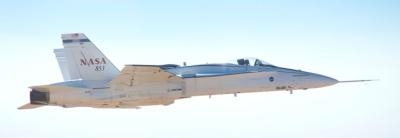Tue, Nov 26, 2013
Testing Systems That Will Guide The SLS Heavy Lift Booster On Liftoff
NASA has completed the first tests with an F/A-18 research jet to evaluate the autonomous flight control system for the agency's Space Launch System (SLS) rocket. The system, called the Adaptive Augmenting Controller, will allow SLS to respond to vehicle and environmental variations such as winds or vehicle flexibility after it blasts off the launch pad and heads toward space.

This is the first time a flight control system for a NASA rocket is being designed to adjust autonomously to unexpected conditions during actual flight rather than pre-flight predictions. This ability to make real-time adjustments to the autopilot provides enhanced performance and increased safety for the crew. The tests were flown Nov. 14-15 out of NASA's Dryden Flight Research Center at Edwards Air Force Base, CA. During the flights, more than 40 tests were conducted using SLS-like trajectories. The system was evaluated in different scenarios for up to 70 seconds at a time to match the rocket's dynamics for the majority of its flight from liftoff to solid rocket booster separation.
"By flying a high-performance F/A-18 jet in a manner similar to our rocket, we're able to simulate SLS's flight conditions and improve our software," said Tannen VanZwieten, SLS flight controls working group lead. "The innovative system that we are testing at Dryden is advancing flight control technology by adding an adaptive element which is new for launch vehicles. We're using this technology to expand the capabilities of the SLS a bit more than what is possible with a traditional design."
During the flight, NASA simulated both normal and abnormal flight conditions, such as sloshing propellant, and identified key aircraft vibrational characteristics. The flight test data will be used to refine software for SLS and plans for future F/A-18 flights, which will run through the end of the year. "This is an example of how advanced rocket technology can be checked out in flight without having to be launched into space," said John Carter, project manager for the flight tests at Dryden. "Doing this work on the F/A-18 test bed allows for low-cost, quick-schedule tests that can be repeated many times in order to gain confidence in the advanced controls technology, providing some unique testing advantages for this type of control system validation."

This flight control system will be ready for the first flight test of the SLS, scheduled for 2017. That flight will feature a 77-ton lift capacity configuration and carry an uncrewed Orion spacecraft beyond low-Earth orbit to test the performance of the integrated system. As the SLS evolves, it will provide an unprecedented lift capability of 143 tons to enable missions even farther into our solar system to places such as an asteroid and Mars.
(Pictured Top: An F/A-18 research jet simulated various flight conditions that NASA's Space Launch System may experience as it makes its way from the launch pad to space, to evaluate the rocket's flight control system. NASA / Jim Ross. Bottom: artist's rendering of SLS launch)
More News
Very High Frequency The frequency band between 30 and 300 MHz. Portions of this band, 108 to 118 MHz, are used for certain NAVAIDs; 118 to 136 MHz are used for civil air/ground voi>[...]
Aero Linx: Aviation Suppliers Association Established February 25, 1993, the Aviation Suppliers Association (ASA), based in Washington, D.C., is a not-for-profit association, repre>[...]
Have A Story That NEEDS To Be Featured On Aero-News? Here’s How To Submit A Story To Our Team Some of the greatest new stories ANN has ever covered have been submitted by our>[...]
From 2021 (YouTube Version): Colorado Campus Offers aVariety Of Aerospace Entertainment And Education Wings over the Rockies Exploration of Flight is the second location for the Wi>[...]
Also: Paramotor Champ's, Electric Ultralight, ICON BK Update, Burt Rutan at Oshkosh! The Popular Rotorcraft Association is reaching out for help in rebuilding their private runway >[...]
 ANN's Daily Aero-Term (05.17.24): Very High Frequency
ANN's Daily Aero-Term (05.17.24): Very High Frequency ANN's Daily Aero-Linx (05.17.24)
ANN's Daily Aero-Linx (05.17.24) ANN FAQ: Submit a News Story!
ANN FAQ: Submit a News Story! Classic Aero-TV: ANN Visits Wings Over The Rockies Exploration Of Flight
Classic Aero-TV: ANN Visits Wings Over The Rockies Exploration Of Flight Airborne Affordable Flyers 05.16.24: PRA Runway, Wag-Aero Sold, Young Eagles
Airborne Affordable Flyers 05.16.24: PRA Runway, Wag-Aero Sold, Young Eagles




